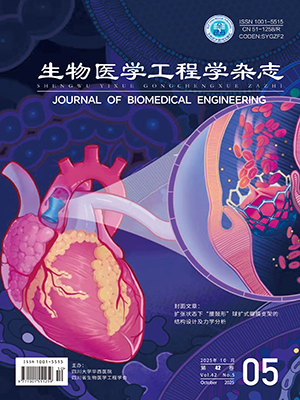| 1. |
Mozaffarian D, Benjamin E J, Go A S, et al. Heart disease and stroke statistics-2016 update: a report from the American heart association. Circulation, 2016, 133(4): e38-e48.
|
| 2. |
吴宏健, 李莉娜, 李龙, 等. 脑卒中后手功能康复机器人综合干预研究进展. 生物医学工程学杂志, 2019, 36(1): 151-156.
|
| 3. |
王萌亚, 王仲朋, 陈龙, 等. 卒中后运动神经反馈康复训练研究进展与前景. 中国生物医学工程学报, 2019, 38(6): 742-752.
|
| 4. |
Raz J L, Soroker N, Friedman J, et al. Effect of tDCS on reaching kinematics in subacute stroke patients. Annals of Physical and Rehabilitation Medicine, 2018, 61: 36-37.
|
| 5. |
杨冬菊, 王玉平. 经颅直流电刺激技术及临床应用进展. 脑与神经疾病杂志, 2016, 24(3): 192-195.
|
| 6. |
Fregni F, Boggio P S, Mansur C G, et al. Transcranial direct current stimulation of the unaffected hemisphere in stroke patients. Neuroreport, 2005, 16(14): 1551-1555.
|
| 7. |
Pavlova E, Semenov R V, Guekht A B. Comparison of one-session anodal tDCS effects on fine motor control in subacute and chronic stroke patients. Journal of the Neurological Sciences, 2019, 405(S): 2-3.
|
| 8. |
Elsner B, Kugler J, Pohl M, et al. Transcranial direct current stimulation (tDCS) for improving aphasia in patients with aphasia after stroke. Cochrane Database Syst Rev, 2015, 6(5): CD009760.
|
| 9. |
Di Lazzaro V, Dileone M, Capone F, et al. Immediate and late modulation of interhemipheric imbalance with bilateral transcranial direct current stimulation in acute stroke. Brain Stimul, 2014, 7(6): 841-848.
|
| 10. |
Tedesco T L, Burridge J H, Hughes A M, et al. Multiple sessions of transcranial direct current stimulation and upper extremity rehabilitation in stroke: a review and meta-analysis. Clin Neurophysiol, 2016, 127(1): 946-955.
|
| 11. |
尹宁, 徐桂芝†, 周茜. 磁刺激穴位复杂脑功能网络构建与分析. 物理学报, 2013, 62(11): 561-568.
|
| 12. |
van den Heuvel M P, Hulshoff P H. Exploring the brain network: a review on resting-state fMRI functional connectivity. Eur Neuropsychopharmacol, 2010, 20(8): 519-534.
|
| 13. |
于洪丽, 徐桂芝, 付灵弟, 等. 基于脑电图的不同频率磁刺激内关穴脑网络分析. 中国生物医学工程学报, 2016, 35(6): 749-753.
|
| 14. |
Friston K J. Functional and effective connectivity in neuroimaging: a synthesis. Hum Brain Mapp, 1994, 2(1-2): 56-78.
|
| 15. |
Foresta F L, Morabito F C, Marino S, et al. High-density EEG signal processing based on active-source reconstruction for brain network analysis in Alzheimer's disease. Electronics (Basel), 2019, 8(9): 1-14.
|
| 16. |
Jin M, Zhang Z, Bai Z, et al. Timing-dependent interaction effects of tDCS with mirror therapy on upper extremity motor recovery in patients with chronic stroke: a randomized controlled pilot study. J Neurol Sci, 2019, 405: 116436.
|
| 17. |
Ochi M, Saeki S, Oda T, et al. Effects of anodal and cathodal transcranial direct current stimulation combined with robotic therapy on severely affected arms in chronic stroke patients. J Rehabil Med, 2013, 45(2): 137-140.
|
| 18. |
Zhang Ziqing, Sun Shu, Yi Ming, et al. MIC as an appropriate method to construct the brain functional network. Biomed Res Int, 2015, 2015(1): 825136.
|
| 19. |
龙雨涵, 王彬, 薛洁, 等. 非线性脑区相关性分析及动态脑网络构建方法. 信号处理, 2018, 34(8): 963-973.
|
| 20. |
Albert R, Barabasi A L. Statistical mechanics of complex networks. Review of Modern Physics, 2001, 74(1): 47-97.
|
| 21. |
梁夏, 王金辉, 贺永. 人脑连接组研究: 脑结构网络和脑功能网络. 科学通报, 2010, 55(16): 1565-1583.
|
| 22. |
Zhang Xuejun, Wang Longqiang, Ding Yuhan, et al. Brain network analysis of schizophrenia based on the functional connectivity. Chinese Journal of Electronics, 2019, 28(3): 535-541.
|
| 23. |
张天恒, 王磊, 郭苗苗, 等. 虚拟现实视觉体验对脑功能网络的影响. 生物医学工程学杂志, 2020, 37(2): 251-261.
|
| 24. |
Watts D J, Strogatz S H. Collective dynamics of ‘small-world’ networks. Nature, 1998, 393(6684): 440-442.
|
| 25. |
Friston K J, Frith C D, Liddle P F, et al. Functional connectivity: the principal-component analysis of large (PET) data sets. J Cereb Blood Flow Metab, 1993, 13(1): 5-14.
|
| 26. |
Desowska A, Turner D L. Dynamics of brain connectivity after stroke. Rev Neurosci, 2019, 30(6): 605-623.
|
| 27. |
Guggisberg A G, Koch P J, Hummel F C, et al. Brain networks and their relevance for stroke rehabilitation. Clin Neurophysiol, 2019, 130(7): 1098-1124.
|
| 28. |
Pellegrino G, Maran M, Turco C, et al. Bilateral transcranial direct current stimulation reshapes resting-state brain networks: a magnetoencephalography assessment. Neural Plast, 2018, 2018: 2782804.
|
| 29. |
Fleming M K, Rothwell J C, Sztriha L, et al. The effect of transcranial direct current stimulation on motor sequence learning and upper limb function after stroke. Clin Neurophysiol, 2017, 128(7): 1389-1398.
|
| 30. |
Lee D G, Lee D Y. Effects of adjustment of transcranial direct current stimulation on motor function of the upper extremity in stroke patients. J Phys Ther Sci, 2015, 27(11): 3511-3513.
|




